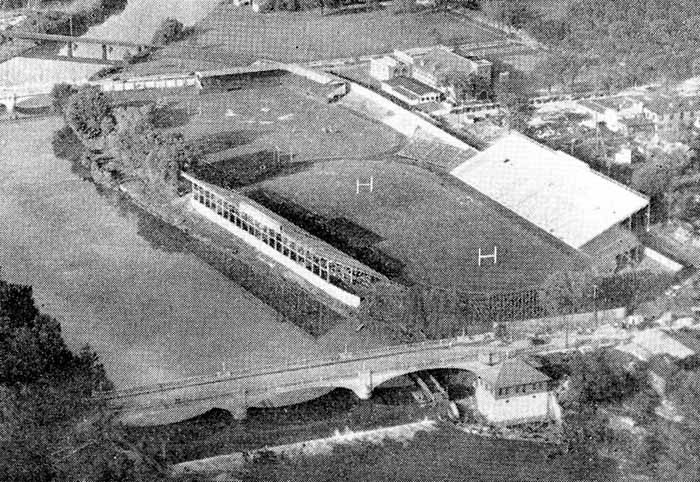A
cramped “Athletic Park” about 1925 along the Iowa River between
Burlington Street (foreground) and
Iowa Avenue included seating which cantilevered out above the river. On
the opposite side seating bridged
above the Crandic Railway tracks. Baseball stands (top center) backed
up to Iowa Avenue and the railroad tracks.
|
By Bob Hibbs Baseball was the leading sporting event at the
University of Iowa a century ago, but football was gaining momentum
with fan support from the entire state. UI won the Western Conference (Big Ten) title in
1900, its first year in the league, sparking widespread awe for an
endeavor which dated only to 1889 when Iowa played its first
intercollegiate football game against Iowa College in Grinnell, now
renamed Grinnell College. The Iowa City team lost 24-0 in Grinnell. The sport as a variation from rugby had existed
only 20 years since its inception at Rutgers. Eastern schools picked it
up first, with players there bringing it west. It came to Iowa with Martin Simpson, a graduate of
Cincinnati, who moved to Iowa City to teach English at the university.
He had not played the game, but was familiar with it. He suggested Iowa
form a team and seek opponents. Iowa and Iowa College had met occasionally on the
baseball diamond during the previous two decades and a rivalry had
developed. Iowa issued a general challenge in the school newspaper in
Iowa City, which landed before partisans at the Grinnell school, and
was quickly accepted. Unbeknownst to Iowa, two members of the Grinnell
team had played prep football during their days at eastern schools.
Iowa was not similarly blessed, fielding only participants new to the
game. Rules provided for two 45-minute halves (now 40
minutes long), on a field 330-feet long (now 300 feet), with no forward
passing and goals kicked from the field scored as five points (now
three), a touchdown counted four points (now six) and a goal following
a touchdown two points (now one). Another rule required that the quarterback receive
the ball from the center (then called the “snapper-back”) on every
play, but the quarterback was prohibited from carrying the ball
himself; he had to hand it off. All in all, quite a different game than
is played today. After going 0-1 in 1889, Iowa climbed to 1-1 the
next year, losing again to Grinnell in its first game played in Iowa
City, but beating Iowa Wesleyan 91-0 in Mt. Pleasant on Thanksgiving
Day. A crowd of 1,500 gathered at the Henry County fairgrounds to
witness the game, included Iowa Senator James Harlan and his son-in-law
Robert Lincoln, son of the assassinated president. Thus, Iowa gained its first win on the gridiron. During the era prior to dedication of Kinnick
Stadium in a downpour at homecoming in 1929, the standout seasons, in
addition to 1900, were 1921 and 1922 when Iowa went undefeated through
seven games each season under legendary coach Howard Jones. Beginning during the 1920 season and extending into
1923, Iowa won a record 20 consecutive games with the exploits of such
players as Aubrey Devine at quarterback, Lester Belding at end and Duke
Slater at tackle. In
1921 Slater was the first Iowa black to achieve national honors amid
national championship recognition for the Hawks. Not until the 1939 Ironmen squad played would Iowa
again achieve the football glory of 1921 and 1922. Record crowds in the 25,000 range gathered at
Athletic Park on the east bank of the Iowa River just north of
Burlington Street during the 1920s, prompting the construction of
Kinnick. At their peak, football crowds along the river
actually sat above passing railroad cars on the Crandic Railway’s
interurban line. It caused excitement, but since the cars were
electric, there was no smoke or heat with which to be concerned as
would have been the case with steam engines powered by diesel or
earlier wood-burners. The southwest corner of the west stands projected
out over the river itself; space was, indeed, cramped. Next Saturday: Old Capitol at the 1904 St. Louis World’s Fair. Bob Hibbs collects local postcards and researches history related to them. |
